 |
| August 21, 2018 | Volume 14 Issue 31 |
Mechanical News & Products
Designfax weekly eMagazine
Archives
Partners
Manufacturing Center
Product Spotlight
Modern Applications News
Metalworking Ideas For
Today's Job Shops
Tooling and Production
Strategies for large
metalworking plants
New nylon constant torque hinge
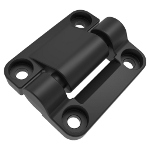 Southco has expanded its line of E6 Constant Torque Hinges with a compact, nylon version designed for small applications. The newest addition to the company's E6 50 Constant Torque Position Control Hinge series measures 45 mm with a torque range of 4 to 16 in./lb and is 65% lighter compared to the standard E6 50 Hinge. It provides constant resistance throughout the entire range of motion, enabling users to easily position doors, display screens, and other mounted components and hold them securely at any desired angle.
Southco has expanded its line of E6 Constant Torque Hinges with a compact, nylon version designed for small applications. The newest addition to the company's E6 50 Constant Torque Position Control Hinge series measures 45 mm with a torque range of 4 to 16 in./lb and is 65% lighter compared to the standard E6 50 Hinge. It provides constant resistance throughout the entire range of motion, enabling users to easily position doors, display screens, and other mounted components and hold them securely at any desired angle.
Learn more.
What injection molding material do I use?
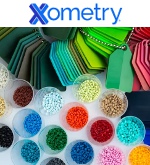 How do you decide what type of plastic to use for your next injection molding project? Xometry can help you narrow your choices. Discover the different strengths and applications for materials that could be ideal for your application by learning about the most common plastic injection molding materials in detail.
How do you decide what type of plastic to use for your next injection molding project? Xometry can help you narrow your choices. Discover the different strengths and applications for materials that could be ideal for your application by learning about the most common plastic injection molding materials in detail.
Read this detailed Xometry article.
What are carbon composite bellows springs?
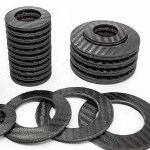 The Carbon Composite Bellows Spring (CCBS) from MW Components is a system of carbon fiber elements that combine to work as a high-performance, lightweight, and design-flexible compression spring meant to replace coil springs or metallic Belleville disc springs. A functional spring is made from several individual elements paired and joined to make a stack. The stack spring rate is determined by the number of elements, the base rate of each element, and their series or parallel orientation in the stack. Applications include motorsports, aerospace, and high-performance activities.
The Carbon Composite Bellows Spring (CCBS) from MW Components is a system of carbon fiber elements that combine to work as a high-performance, lightweight, and design-flexible compression spring meant to replace coil springs or metallic Belleville disc springs. A functional spring is made from several individual elements paired and joined to make a stack. The stack spring rate is determined by the number of elements, the base rate of each element, and their series or parallel orientation in the stack. Applications include motorsports, aerospace, and high-performance activities.
Learn more.
Conductive Brush Ring overcomes current leakage in EV powertrains
 SKF's new Conductive Brush Ring paves the way to greater reliability and longer life in high-performance electric vehicle powertrain systems. Using pure carbon fiber bristles, it provides a reliable electrical connection between an EV eAxle rotor shaft and its housing. When used in combination with SKF Hybrid ceramic ball bearings, it helps to alleviate parasitic current effects that can lead to premature failure in bearings and other components. Available in different configurations for wet (oil-lubricated) motor designs -- and soon for dry (sealed) applications.
SKF's new Conductive Brush Ring paves the way to greater reliability and longer life in high-performance electric vehicle powertrain systems. Using pure carbon fiber bristles, it provides a reliable electrical connection between an EV eAxle rotor shaft and its housing. When used in combination with SKF Hybrid ceramic ball bearings, it helps to alleviate parasitic current effects that can lead to premature failure in bearings and other components. Available in different configurations for wet (oil-lubricated) motor designs -- and soon for dry (sealed) applications.
Learn more.
hyperMILL 2024 CAD/CAM software suite
 OPEN MIND Technologies has introduced its latest hyperMILL 2024 CAD/CAM software suite, which includes a range of powerful enhancements to its core toolpath capabilities, as well as new functionality for increased NC programming efficiency in applications ranging from 2.5D machining to 5-axis milling. New and enhanced capabilities include: Optimized Deep Hole Drilling, a new algorithm for 3- and 5-axis Rest Machining, an enhanced path layout for the 3D Plane Machining cycle, better error detection, and much more.
OPEN MIND Technologies has introduced its latest hyperMILL 2024 CAD/CAM software suite, which includes a range of powerful enhancements to its core toolpath capabilities, as well as new functionality for increased NC programming efficiency in applications ranging from 2.5D machining to 5-axis milling. New and enhanced capabilities include: Optimized Deep Hole Drilling, a new algorithm for 3- and 5-axis Rest Machining, an enhanced path layout for the 3D Plane Machining cycle, better error detection, and much more.
Learn more.
One-part epoxy changes from red to clear under UV
 Master Bond UV15RCL is a low-viscosity, cationic-type UV-curing system with a special color-changing feature. The red material changes to clear once exposed to UV light, indicating that there is UV light access across the adhesive material. Although this change in color from red to clear does not indicate a full cure, it does confirm that the UV light has reached the polymer. This epoxy is an excellent electrical insulator. UV15RCL adheres well to metals, glass, ceramics, and many plastics, including acrylics and polycarbonates.
Master Bond UV15RCL is a low-viscosity, cationic-type UV-curing system with a special color-changing feature. The red material changes to clear once exposed to UV light, indicating that there is UV light access across the adhesive material. Although this change in color from red to clear does not indicate a full cure, it does confirm that the UV light has reached the polymer. This epoxy is an excellent electrical insulator. UV15RCL adheres well to metals, glass, ceramics, and many plastics, including acrylics and polycarbonates.
Learn more.
SPIROL Press-N-Lok™ Pin for plastic housings
 The Press-N-Lok™ Pin was designed to permanently retain two plastic components to each other. As the pin is inserted, the plastic backfills into the area around the two opposing barbs, resulting in maximum retention. Assembly time is quicker, and it requires lower assembly equipment costs compared to screws and adhesives -- just Press-N-Lok™!
The Press-N-Lok™ Pin was designed to permanently retain two plastic components to each other. As the pin is inserted, the plastic backfills into the area around the two opposing barbs, resulting in maximum retention. Assembly time is quicker, and it requires lower assembly equipment costs compared to screws and adhesives -- just Press-N-Lok™!
Learn more about the new Press-N-Lok™ Pin.
Why hybrid bearings are becoming the new industry standard
 A combination of steel outer and inner rings with ceramic balls or rollers is giving hybrid bearings unique properties, making them suitable for use in a wide range of modern applications. SKF hybrid bearings make use of silicon nitride (twice as hard as bearing steel) rolling elements and are available as ball bearings, cylindrical roller bearings, and in custom designs. From electric erosion prevention to friction reduction and extended maintenance intervals, learn all about next-gen hybrid bearings.
A combination of steel outer and inner rings with ceramic balls or rollers is giving hybrid bearings unique properties, making them suitable for use in a wide range of modern applications. SKF hybrid bearings make use of silicon nitride (twice as hard as bearing steel) rolling elements and are available as ball bearings, cylindrical roller bearings, and in custom designs. From electric erosion prevention to friction reduction and extended maintenance intervals, learn all about next-gen hybrid bearings.
Read the SKF technical article.
3M and Ansys train engineers on simulating adhesives
 Ansys and 3M have created an advanced simulation training program enabling engineers to enhance the design and sustainability of their products when using tapes and adhesives as part of the design. Simulation enables engineers to validate engineering decisions when analyzing advanced polymeric materials -- especially when bonding components made of different materials. Understand the behavior of adhesives under real-world conditions for accurate modeling and design.
Ansys and 3M have created an advanced simulation training program enabling engineers to enhance the design and sustainability of their products when using tapes and adhesives as part of the design. Simulation enables engineers to validate engineering decisions when analyzing advanced polymeric materials -- especially when bonding components made of different materials. Understand the behavior of adhesives under real-world conditions for accurate modeling and design.
Read this informative Ansys blog.
New FATH T-slotted rail components in black from AutomationDirect
 Automation-Direct has added a wide assortment of black-colored FATH T-slotted hardware components to match their SureFrame black anodized T-slotted rails, including: cube connectors (2D and 3D) and angle connectors, joining plates of many types, brackets, and pivot joints. Also included are foot consoles, linear bearings in silver and black, cam lever brakes, and L-handle brakes. FATH T-slotted hardware components are easy to install, allow for numerous T-slotted structure configurations, and have a 1-year warranty against defects.
Automation-Direct has added a wide assortment of black-colored FATH T-slotted hardware components to match their SureFrame black anodized T-slotted rails, including: cube connectors (2D and 3D) and angle connectors, joining plates of many types, brackets, and pivot joints. Also included are foot consoles, linear bearings in silver and black, cam lever brakes, and L-handle brakes. FATH T-slotted hardware components are easy to install, allow for numerous T-slotted structure configurations, and have a 1-year warranty against defects.
Learn more.
Weird stuff: Moon dust simulant for 3D printing
 Crafted from a lunar regolith simulant, Basalt Moon Dust Filamet™ (not a typo) available from The Virtual Foundry closely mirrors the makeup of lunar regolith found in mare regions of the Moon. It enables users with standard fused filament fabrication (FFF) 3D printers to print with unparalleled realism. Try out your ideas before you go for that big space contract, or help your kid get an A on that special science project.
Crafted from a lunar regolith simulant, Basalt Moon Dust Filamet™ (not a typo) available from The Virtual Foundry closely mirrors the makeup of lunar regolith found in mare regions of the Moon. It enables users with standard fused filament fabrication (FFF) 3D printers to print with unparalleled realism. Try out your ideas before you go for that big space contract, or help your kid get an A on that special science project.
Learn more.
Break the mold with custom injection molding by Rogan
 With 90 years of industry experience, Rogan Corporation possesses the expertise to deliver custom injection molding solutions that set businesses apart. As a low-cost, high-volume solution, injection molding is the most widely used plastics manufacturing process. Rogan processes include single-shot, two-shot, overmolding, and assembly. Elevate your parts with secondary operations: drilling and tapping, hot stamping, special finishes, punch press, gluing, painting, and more.
With 90 years of industry experience, Rogan Corporation possesses the expertise to deliver custom injection molding solutions that set businesses apart. As a low-cost, high-volume solution, injection molding is the most widely used plastics manufacturing process. Rogan processes include single-shot, two-shot, overmolding, and assembly. Elevate your parts with secondary operations: drilling and tapping, hot stamping, special finishes, punch press, gluing, painting, and more.
Learn more.
World's first current-carrying fastening technology
 PEM® eConnect™ current-carrying pins fromÔÇ»Penn-Engineering provide superior electrical connections in applications that demand high performance from internal components, such as automotive electronics. This first-to-market tech provides repeatable, consistent electrical joints and superior installation unmatched by traditional fastening methods. Features include quick and secure automated installation, no hot spots or poor conductivity, and captivation options that include self-clinching and broaching styles.
PEM® eConnect™ current-carrying pins fromÔÇ»Penn-Engineering provide superior electrical connections in applications that demand high performance from internal components, such as automotive electronics. This first-to-market tech provides repeatable, consistent electrical joints and superior installation unmatched by traditional fastening methods. Features include quick and secure automated installation, no hot spots or poor conductivity, and captivation options that include self-clinching and broaching styles.
Learn more about eConnect pins.
New interactive digital catalog from EXAIR
 EXAIR's latest catalog offers readers an incredible source of innovative solutions for common industrial problems like conveying, cooling, cleaning, blowoff, drying, coating, and static buildup. This fully digital and interactive version of Catalog 35 is designed for easy browsing and added accessibility. Customers can view, download, print, and save either the full catalog or specific pages and sections. EXAIR products are designed to conserve compressed air and increase personnel safety in the process. Loaded with useful information.
EXAIR's latest catalog offers readers an incredible source of innovative solutions for common industrial problems like conveying, cooling, cleaning, blowoff, drying, coating, and static buildup. This fully digital and interactive version of Catalog 35 is designed for easy browsing and added accessibility. Customers can view, download, print, and save either the full catalog or specific pages and sections. EXAIR products are designed to conserve compressed air and increase personnel safety in the process. Loaded with useful information.
Check out EXAIR's online catalog.
5 cost-saving design tips for CNC machining
 Make sure your parts meet expectations the first time around. Xometry's director of application engineering, Greg Paulsen, presents five expert tips for cutting costs when designing custom CNC machined parts. This video covers corners and radii, designing for deep pockets, thread depths, thin walls, and more. Always excellent info from Paulsen at Xometry.
Make sure your parts meet expectations the first time around. Xometry's director of application engineering, Greg Paulsen, presents five expert tips for cutting costs when designing custom CNC machined parts. This video covers corners and radii, designing for deep pockets, thread depths, thin walls, and more. Always excellent info from Paulsen at Xometry.
View the video.
MIT mathematicians solve age-old spaghetti mystery
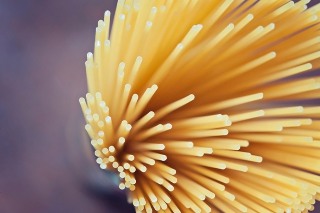
Could a dry spaghetti noodle ever be coerced to break into only two pieces? [Images: Courtesy of the researchers]
Got a box of spaghetti in your pantry? Try this experiment: Pull out a single spaghetti stick and hold it at both ends. Now bend it until it breaks. How many fragments did you make? If the answer is three or more, pull out another stick and try again. Can you break the noodle in two? If not, you're in very good company.
The spaghetti challenge has flummoxed even the likes of famed physicist Richard Feynman (MIT '39), who once spent a good portion of an evening breaking pasta and looking for a theoretical explanation for why the sticks refused to snap in two.
Feynman's kitchen experiment remained unresolved until 2005, when physicists from France pieced together a theory to describe the forces at work when spaghetti -- and any long, thin rod -- is bent. They found that when a stick is bent evenly from both ends, it will break near the center, where it is most curved. This initial break triggers a "snap-back" effect and a bending wave, or vibration, that further fractures the stick. Their theory, which won the 2006 Ig Nobel Prize, seemed to solve Feynman's puzzle. But a question remained: Could spaghetti ever be coerced to break in two?
The answer, according to a new MIT study, is yes -- with a twist.
In a paper published recently in the Proceedings of the National Academy of Sciences, researchers report that they have found a way to break spaghetti in two -- by both bending and twisting the dry noodles. They carried out experiments with hundreds of spaghetti sticks, bending and twisting them with an apparatus they built specifically for the task. The team found that if a stick is twisted past a certain critical degree, then slowly bent in half, it will, against all odds, break in two.
The researchers say the results may have applications beyond culinary curiosities, such as enhancing the understanding of crack formation and how to control fractures in other rod-like materials such as multifiber structures, engineered nanotubes, or even microtubules in cells.
"It will be interesting to see whether and how twist could similarly be used to control the fracture dynamics of two-dimensional and three-dimensional materials," says co-author J÷rn Dunkel, associate professor of physical applied mathematics at MIT. "In any case, this has been a fun interdisciplinary project started and carried out by two brilliant and persistent students -- who probably don't want to see, break, or eat spaghetti for a while."
The two students are Ronald Heisser (MIT '16), now a graduate student at Cornell University, and Vishal Patil, a mathematics graduate student in Dunkel's group at MIT. Their co-authors are Norbert Stoop, instructor of mathematics at MIT, and Emmanuel Villermaux of UniversitÚ Aix Marseille.
A deep dish dive
Heisser, together with project partner Edgar Gridello, originally took up the challenge of breaking spaghetti in the spring of 2015, as a final project for 18.354 (Nonlinear Dynamics: Continuum Systems), a course taught by Dunkel. They had read about Feynman's kitchen experiment, and wondered whether spaghetti could somehow be broken in two and whether this split could be controlled.
"They did some manual tests, tried various things, and came up with an idea that when he twisted the spaghetti really hard and brought the ends together, it seemed to work and it broke into two pieces," Dunkel says. "But you have to twist really strongly. And Ronald wanted to investigate more deeply."
So Heisser built a mechanical fracture device to controllably twist and bend sticks of spaghetti. Two clamps on either end of the device hold a stick of spaghetti in place. A clamp at one end can be rotated to twist the dry noodle by various degrees, while the other clamp slides toward the twisting clamp to bring the two ends of the spaghetti together, bending the stick.
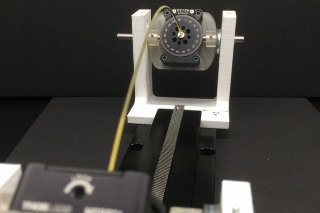
To investigate, MIT researchers carried out experiments with hundreds of spaghetti sticks, bending and twisting them with an apparatus they built specifically for the task.
Heisser and Patil used the device to bend and twist hundreds of spaghetti sticks, and they recorded the entire fragmentation process with a camera at up to a million frames per second. In the end, they found that by first twisting the spaghetti at almost 360 degrees, then slowly bringing the two clamps together to bend it, the stick snapped exactly in two. The findings were consistent across two types of spaghetti: Barilla No. 5 and Barilla No. 7, which have slightly different diameters.
Noodle twist
In parallel, Patil began to develop a mathematical model to explain how twisting can snap a stick in two. To do this, he generalized previous work by the French scientists Basile Audoly and Sebastien Neukirch, who developed the original theory to describe the "snap-back effect," in which a secondary wave caused by a stick's initial break creates additional fractures, causing spaghetti to mostly snap in three or more fragments.
Patil adapted this theory by adding the element of twisting, and looked at how twist should affect any forces and waves propagating through a stick as it is bent. From his model, he found that, if a 10-in.-long spaghetti stick is first twisted by about 270 degrees and then bent, it will snap in two, mainly due to two effects. The snap-back, in which the stick will spring back in the opposite direction from which it was bent, is weakened in the presence of twist. And the twist-back, where the stick will essentially unwind to its original straightened configuration, releases energy from the rod, preventing additional fractures.
"Once it breaks, you still have a snap-back because the rod wants to be straight," Dunkel explains. "But it also doesn't want to be twisted."
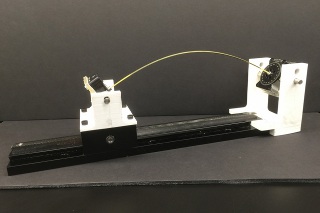
The team found that if a stick is twisted past a certain critical degree, then slowly bent in half, it will, against all odds, break in two.
Just as the snap-back will create a bending wave, in which the stick will wobble back and forth, the unwinding generates a "twist wave," where the stick essentially corkscrews back and forth until it comes to rest. The twist wave travels faster than the bending wave, dissipating energy so that additional critical stress accumulations, which might cause subsequent fractures, do not occur.
"That's why you never get this second break when you twist hard enough," Dunkel says.
The team found that the theoretical predictions of when a thin stick would snap in two pieces, versus three or four, matched with their experimental observations.
"Taken together, our experiments and theoretical results advance the general understanding of how twist affects fracture cascades," Dunkel says.
For now, he says the model is successful at predicting how twisting and bending will break long, thin, cylindrical rods such as spaghetti. As for other pasta types?
"Linguini is different because it's more like a ribbon," Dunkel says. "The way the model is constructed it applies to perfectly cylindrical rods. Although spaghetti isn't perfect, the theory captures its fracture behavior pretty well,"
Source: MIT
Published August 2018
Rate this article
View our terms of use and privacy policy

